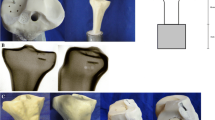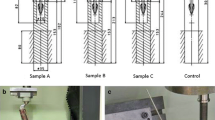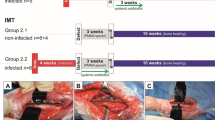Abstract
Purpose
Long bone defects due to fractures resulting from high-energy trauma, infections and tumor resections are problems that orthopedic surgeons commonly face. We investigated the effects of a titanium mesh cage on bone healing with an induced membrane technique.
Methods
Three groups, each composed of eight rabbits, were formed. Extraarticular diaphyseal bone defects were created. Femora of the first group were fixed with an empty titanium mesh cage and two K-wires. After formation of the defect, polymethylmethacrylate was inserted and fixed with a K-wire in the second group. At the third week, the cement was removed, a sterilized cancellous graft-filled titanium mesh cage was placed into the defect, and the membrane that was previously formed over the cement was placed on the cage and repaired. In the third group, sterilized cancellous grafts were filled into the titanium mesh cage, and the titanium mesh cage was fitted into the bone defect area.
Results
At the end of the third month, all subjects were killed. Radiological data revealed that the healing of the bone in the second and third groups was significantly better than that in the first group. There was no difference between the second and third groups. A histological evaluation of the healing status, such as fibrous tissue, cartilage tissue and mature or immature bone formation, was performed. Histological healing in the second and third groups was also significantly better than that in the first group.
Conclusion
We concluded that the combination of membrane-induced bone healing and graft-filled titanium mesh cages expedites osteogenesis in extraarticular bone defects.




Similar content being viewed by others
Availability of data and materials
Not applicable.
References
Wiese A, Pape HC (2010) Bone Defects caused by high-energy injuries, bone loss, infected nonunions, and nonunions. Orthopedic Clin 41:1–4. https://doi.org/10.1016/J.OCL.2009.07.003
Pelissier P, Masquelet AC, Bareille R, Mathoulin Pelissier S, Amedee J (2004) Induced membranes secrete growth factors including vascular and osteoinductive factors and could stimulate bone regeneration. J Orthop Res 22:73–79. https://doi.org/10.1016/S0736-0266(03)00165-7
Reichert JC, Saifzadeh S, Wullschleger ME, Epari DR, Schütz MA, Duda GN, Schell H, van Griensven M, Redl H, Hutmacher DW (2009) The challenge of establishing preclinical models for segmental bone defect research. Biomaterials 30:2149–2163. https://doi.org/10.1016/J.BIOMATERIALS.2008.12.050
Giannoudis P, Dinopoulos H, Tsiridis E (2005) Bone substitutes: an update. Injury 3:20–27. https://doi.org/10.1016/j.injury.2005.07.029
Tsuchiya H, Tomita K (2003) Distraction osteogenesis for treatment of bone loss in the lower extremity. J Orthop Sci 8:116–124. https://doi.org/10.1007/S007760300020
Hu QT, Jiang QW, Su GL, Shen JZ, Shen X (1980) Free vascularized bone graft. Chin Med J (Engl) 93:753–757
Masquelet AC (2003) Muscle reconstruction in reconstructive surgery: Soft tissue repair and long bone reconstruction. Langenbeck’s Arch Surg 388:344–346. https://doi.org/10.1007/S00423-003-0379-1
Ayvaz M, Bekmez S, Yucekul A (2018) Titanium mesh cage as an alternative reconstruction method for epiphyseal-sparing tumour resections in children. J Pediatric Orthopaedics B 27:350–355. https://doi.org/10.1097/BPB.0000000000000482
Attias N, Lehman R, Bodell LS (2005) Surgical management of a long segmental defect of the humerus using a cylindrical titanium mesh cage and plates: a case report. J Orthop Trauma 19:211–216. https://doi.org/10.1097/00005131-200503000-00011
Attias N, Thabet AM, Prabhakar G, Dollahite JA, Gehlert RJ, DeCoster TA (2018) Management of extra-articular segmental defects in long bone using a titanium mesh cage as an adjunct to other methods of fixation. Bone Joint J 100B:646–651. https://doi.org/10.1302/0301-620X.100B5.BJJ-2017-0817.R2
Yang J, Chen HJ, Zhu XD, Vaidya S, Xiang Z, Fan YJ, Zhang XD (2014) Enhanced repair of a critical-sized segmental bone defect in rabbit femur by surface microstructured porous titanium. J Mater Sci Mater Med 25:1747–1756. https://doi.org/10.1007/S10856-014-5202-8
Lane J, Sandhu H (1987) Current approaches to experimental bone grafting. Orthop Clin North Am 18:213–225. https://doi.org/10.1016/S0030-5898(20)30385-0
Huo MH, Troiano NW, Pelker RR, Gundberg CM, Friedlaender GE (1991) The influence of ibuprofen on fracture repair: Biomechanical, biochemical, histologic, and histomorphometric parameters in rats. J Orthop Res 9:383–390. https://doi.org/10.1002/JOR.1100090310
Cobos J, Lindsey R, Gugala Z (2000) The cylindrical titanium mesh cage for treatment of a long bone segmental defect: description of a new technique and report of two cases. J Orthop Trauma 14:54–59. https://doi.org/10.1097/00005131-200001000-00011
Lindsey RW, Gugala Z, Milne E, Sun M, Gannon FH, Latta LL (2006) The efficacy of cylindrical titanium mesh cage for the reconstruction of a critical-size canine segmental femoral diaphyseal defect. Wiley Online Library 24:1438–1453. https://doi.org/10.1002/jor.20154
Fujibayashi S, Kim H, Neo M, Uchida M (2016) Repair of segmental long bone defect in rabbit femur using bioactive titanium cylindrical mesh cage. Biomaterials 24:3445–51. Doi: https://doi.org/10.1016/s0142-9612(03)00221-7
Masquelet A, Fitoussi F, Begue T (2000) Reconstruction of the long bones by the induced membrane and spongy autograft. Ann Chir 45:346–353
Flamans B, Pauchot J, Petite H, Blanchet N (2010) Use of the induced membrane technique for the treatment of bone defects in the hand or wrist, in emergency. Chirurgie de lamain 29:307–314. https://doi.org/10.1016/j.main.2010.06.008
Viateau V, Ve Guillemin G, Bousson V, Oudina K, Hannouche D, Sedel L, Logeart-Avramoglou D, Petite H (2007) Long-bone critical-size defects treated with tissue-engineered grafts: a study on sheep. Wiley Online Library 25:741–749. https://doi.org/10.1002/jor.20352
Reynders P, Broos PLO (2003) The use of cylindrical titanium mesh cages in the treatment of post-traumatic segmental bone loss of the femur. Osteosynthesis Trauma Care 11:99–104. https://doi.org/10.1055/s-2003-42524
Ryzewicz M, Morgan SJ, Linford E, Thwing JI, de Resende GVP, Smith WR (2009) Central bone grafting for nonunion of fractures of the tibia: A retrospective series. J Bone Joint Surg Ser B 91:522–529. https://doi.org/10.1302/0301-620X.91B4.21399
Acknowledgements
This research funded by Çukurova University Scientific Research Projects Coordination Unit. Project number: TTU-2017-8360. Corresponding author Onur KAYA has received research support from Çukurova University Scientific Research Projects Coordination Unit. The other authors declare they have no financial interests.
Funding
We would like to thank Çukurova University Scientific Research Projects Coordination Unit for funding the study.
Author information
Authors and Affiliations
Contributions
KO performed the animal experiments, funding acquisition,processed samples, analyzed and interpreted the data, and wrote the manuscript. MA processed samples, analyzed and interpreted the data, and wrote the manuscript. ÖSB, MAD, and MT supported in sample processing and supported in data analysis and interpretation. CÖ designed the study, guided the animal experiments, interpreted the data, and edited the manuscript. KEA analyzed pathological evaluation. All authors have revised the manuscript for important intellectual content and have approved the submission of the manuscript.
Corresponding author
Ethics declarations
Conflict of interest
The authors have no competing interests to declare that are relevant to the content of this article.
Animal study design
This study was performed in line with the principles of the Declaration of Helsinki.
Ethical approval
Ethical approval for this study was obtained from Ethics Committee of Cukurova University before the initiation of the study (27.10.2016/9).
Consent to participate
Not applicable.
Consent to publish
Not applicable.
Additional information
Publisher's Note
Springer Nature remains neutral with regard to jurisdictional claims in published maps and institutional affiliations.
Rights and permissions
About this article
Cite this article
Kaya, O., Mirioglu, A., Ozkan, C. et al. Reconstruction of critical size segmental femoral diaphyseal defects of New Zealand rabbits by using combined titanium mesh cage and induced membrane technique. Eur J Orthop Surg Traumatol 33, 629–637 (2023). https://doi.org/10.1007/s00590-022-03330-y
Received:
Accepted:
Published:
Issue Date:
DOI: https://doi.org/10.1007/s00590-022-03330-y




